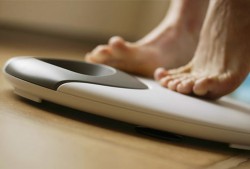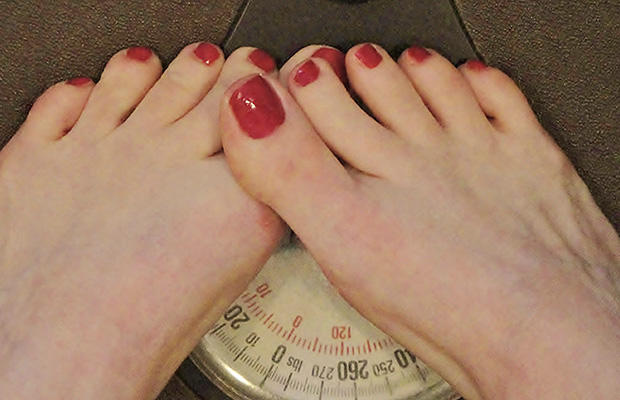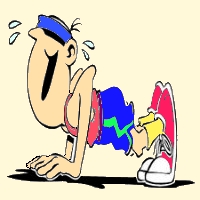How to Lose 25 Pounds in Two Months
You'll find plenty of diets that promise to help you to lose weight quickly. But the fact of the matter is that studies have shown 95% of diets fail and lost weight is often gained back in just a year. [1] Such diets can also be torturous and leave your body feeling weak and fatigued. If you want to lose weight and really keep it off, you need to make adjustments to how you live, like introducing portion control and exercise. Start with small changes to your diet, exercise routine and lifestyle to help you lose 25 pounds in 2 months.
Steps
Part 1 Getting Ready to Lose 25 Pounds
-
1
Talk to your doctor. Losing 25 pounds in 2 months is a lofty goal. Due to the type of diet and exercise plan this type of weight loss requires, it's going to be a smart idea to talk to your doctor prior to starting your weight loss.
- A low calorie diet paired with a lot of exercise is generally safe for most people. However, talk to your doctor about exactly what type of diet and exercise you plan on doing. He/she will be able to tell you whether or not this is safe for your current health conditions.
- Speak to a registered dietitian. These nutrition professionals will be able to guide you on an appropriate eating pattern to meet your goal. They may be able to give you an specific meal plan, types of foods to include and what to avoid.
-
2
Start a journal. Starting a journal will be a good piece of your diet and exercise program. This is an area to track a variety of things to help you monitor your progress.
- Track your foods and meals in your journal. This will help you stay accountable but also provide you with good information if you're not seeing your desired results.[2]
- Consider tracking your exercise as well. Again, this can help keep you on track.
- Lastly, keep track of your progress. This may mean your weight loss or measurements. If you're not seeing your results, you may need to go back and analyze your food and exercise journals.
-
3
Build a support group. Losing 25 pounds in 2 months will be difficult. You'll need to make a variety of changes to your diet and lifestyle. These changes may be difficult to maintain everyday for 2 months. A support group can help you stay strong the entire two months.[3]
- Find friends, family members or co-workers that will be positive support. Look for people that will help you stay on track, not enable you. Some people may not encourage you through your tough moments and should not be included in your support group.[4]
- Also ask if anyone wants to join you on your new plan. Losing weight and getting in shape is a common goal and finding a friend to go along with you makes the journey more fun.
- You can also check out online support groups or forums of others trying to lose weight. This may also you to connect with other people any time of day.
-
4
Write your diet and exercise plan. To keep yourself organized and on track, take the time to write up your desired diet and exercise plan. These blueprints will answer all your questions of how you're going to lose 25 pounds in 2 months.
- Start with your diet plan. To lose that 25 pounds, you'll need to make the most changes to your diet. You'll also need to be the most strict with your diet. Diet has the most effect on your weight loss.[5]
- Write out your calorie level for each day. Then construct a meal plan that fits into that calorie plan. Include each meal, snack and beverage you plan on consuming throughout the day.[6]
- Write down what type of exercise you're going to be doing, how much to aim for each week and how you're going to divide that up between 7 days.
Part 2 Adding in Physical Activity
-
1
Do enough cardio exercise. Although exercise is not responsible for a large part of weight loss, when you have a loft weight loss goal, you'll need to really increase the amount of cardio exercise you do each day.[7]
- Cardio or aerobic activity is the type of exercise that's responsible for larger calorie burns compared to strength training. This will be the big support of your weight loss.
- Most health professionals recommend including at least 150 minutes of cardio exercises each week.[8] However, because losing 25 pounds in 2 months is consider a rapid weight loss, you'll need to add in additional activity to help you reach your goal.
- Consider doing at least 300 minutes of cardio each week. This is a lot of exercise, but will really burn additional calories to help you lose weight more quickly.[9]
- Include exercises like: jogging/running, swimming, using the elliptical, aerobics classes, cycling or doing spin class.
-
2
Include regular strength training. Strength training or resistance training does not burn many calories per session, however is important component of overall exercise.
- Strength training helps build and support lean muscle mass during weight loss. In addition, the more lean muscle mass you have the more calories you'll burn at rest.
- Most health experts recommend including at least 2-3 days of strength training each week. Work each major muscle group in your body each day you do strength work.[10]
- If you're having difficulty meeting the 150-300 minutes of cardio each week, cut down on the amount of time you spend doing strength training. In the short term of 2 months, you'll benefit more from doing higher amounts of cardio.[11]
-
3
Increase your baseline activity. Lifestyle or baseline activity are the types of exercise that you include in your everyday life. These types of activities do not burn many calories by themselves, but added up at the end of the day can have a significant effect on the total amount of calories you've burned.[12]
- Lifestyle activities include things like: doing household chores, gardening, walking to and from your car, walking throughout the day and taking the stairs.
- Spend some time when you're coming up with your exercise plan to add in ways you can be more active throughout the day or just move more.
- For example, can you park farther away when you're at the store or at work? Are there ways you can take the stairs instead of the elevator? Can you stand or move more while you're watching TV?
-
4
Consider HIIT. A newer and more trendy form of exercise is called HIIT or high intensity interval training. This type of exercise burns a lot of calories in a short amount of time and can help you reach your weight goal.
- HIIT is a form of exercise that combines bouts of very high intensity cardio activities with short bouts of more moderate intensity activities. HIIT sessions are usually shorter compared to more steady state cardio (like going for a 45 minute jog).[13]
- Although HIIT sessions are shorter, they burn higher amount of calories compared to steady state cardio. In addition, studies have shown that they keep your metabolism (your body's calorie burner) raised long after the workout has been completed.[14]
- In addition to your regular cardio and strength training, consider adding 1-2 sessions of HIIT throughout the week. This extra calorie burn can help you reach that 25 pound goal in 2 months.
Part 3 Managing Your Diet
-
1
Cut calories. To lose weight, you'll need to modify your diet by cutting down on the total amount of calories you eat each day. To lose 25 pounds in 2 months, you'll need to cut out a significant amount of calories each day.
- In general, safe weight loss is considered to be about 1-2 pounds of weight loss each week.[15] To lose 25 pounds in 2 months you'll need to lose about 3 pounds per week. Although this is technically outside of the "safe weight loss" limit, it's a may be a realistic goal for those who stick to a strict diet plan the entire two months.
- You'll need to cut out at least 500 calories each day, but even up to 750 calories daily. This will really help you meet that 25 pound goal.[16]
- Although you'll need to cut out a significant amount of calories each day, it's not typically recommended by health professionals to eat less than 1200 calories daily. A calorie level lower than this may not allow you to consume enough vital nutrients that your body needs to function normally each day.
- In addition, consistently following a calorie limit that is too low may result in the loss of lean muscle mass, not fat mass.
-
2
Pass on the carbs. Many studies show that one of the dieting plans that results in the fastest weight loss is a low-carb diet. These diets not only help you lose weight faster, but typically result in the loss of more fat mass compared to lean muscle mass.[17]
- To follow a low carb diet, you'll need to focus on minimizing the amount of carbohydrates that you consume each day.
- Carbs are found in a variety of foods including: starchy vegetables (like potatoes or peas), legumes (beans and lentils), fruits, dairy products and grains.[18]
- Because carbohydrates are so widespread through a variety of food groups, it's not ideal or realistic to cut out each of those food groups. Focus on minimizing the most carbohydrate rich food groups like grains, starchy vegetables and some fruits.
- Many nutrients found in foods like grains or starchy vegetables are easily consumed from other food groups. Limiting these for a short time period like 2 months isn't considered unhealthy.
- Although fruit is a carbohydrate rich food, you should not avoid all fruit. Choose to have minimal, small amounts of fruit each week. Also choose lower-sugar fruits like: cranberries, raspberries, blackberries and strawberries.[19]
- Also keep fruit to the appropriate serving size of 1/2 cup chopped or small fruit or 1 small piece.[20]
-
3
Fill up on lean protein and non-starchy vegetables. If you're following a low-carb diet, there are two food groups that are left that are considered low carb. Protein and non-starchy vegetables are low carb, low calories and nutrient dense making them an excellent pair for rapid weight loss.
- Aim for 1-2 servings of lean protein at each meal or snack. One serving is about 3-4 oz or about the size of a deck of cards.[21]
- Fill up on as many non-starchy vegetables as you'd like. It's typically recommended to make 1/2 of your plate a vegetable.[22]
- In general, you may notice that half of your plate is a source of lean protein and half is a non-starchy vegetable and the occasional piece of fruit.
-
4
Limit snacks and keep them low calorie. When you're cutting a significant amount of calories from your diet each day and participating in a higher amount of physical activity, there is a chance that you'll feel more hungry or need an extra boost throughout the day. Planning healthy, weight loss friendly snacks is a must.
- If you're trying to follow a more rapid weight loss plan, you'll need to make sure that your snacks fit into your daily calorie goal. Typically a snack of 100-150 calories will work well in your plan.[23]
- Try to stick to one snack daily. Including 2 or more might put you over your daily calorie goal.
- To fit in with your higher protein, lower carb diet, choose snacks that also feature higher protein amounts.
- Examples of low calorie, low carb snacks include: 1/4 cup of almonds, 1/2 cup plain greek yogurt, 3 oz of beef jerky or 1 hard boiled egg.
- Also, only snack if you're feeling truly hungry or need a boost for a workout. If you snack unnecessarily that may lead to slower weight loss or a plateau.
-
5
Drink adequate fluid. Drinking enough clear, hydrating fluids each day is essential for overall health. It'll also become even more important with rapid weight loss and higher amounts of physical activity.
- When you're losing weight, especially when paired with higher intensity or higher amounts of cardio, you'll need to make sure that you're drinking enough to rehydrate after workouts and stay hydrated throughout the day.[24]
- Aim for a minimum of 8 glasses daily or about 64 oz. However, if you're including more physical activity you may need to drink up to 13 glasses daily. This will depend on your exercise, gender and age as well.[25]
- Stick to low or no calorie fluids to help you meet your daily calorie goal. Beverages like water, flavored water, decaf coffee and tea are the best choices.
-
The Most Weight You Can Safely Lose In A Month By Only Changing Your Diet—And 9 Simple Strategies To Get You Started
So, how much weight can you safely lose in a month by changing only yo
-
How To Lose Weight And Feel Great Doing It
TIP! You can’t resist french fries, can you? They’ve gotten in t
-
8 Weight Loss Tips For Teenage Girls
Being a teenage girl is often difficult enough without having to carr
-
Losing Weight As Easy As 1, 2, 3
Many people spend hundreds, even thousands on losing weight programs
-
30 Simple Ways To Rev Your Metabolism
Technically, your metabolism is the process by which your body breaks
-
How to Use Acupressure for Weight Loss
In traditional Chinese acupressure, firm pressure is placed on severa
- DON'T MISS
- These 5 Weight Loss Drugs Really Work—But Heres What Else You Need To Know
- How Important are Vegetables In Losing Weight?
- Celebrity Nutritionist Kimberly Snyder’s Recipe For Optimal Weight Loss
- Priceless Weight Loss Suggestions
- Use These Tips For Healthy Weight-loss
- Follow These Weight Loss Tips
- 3 Solutions To Weight Loss Obstacles When Youre Trying To Lose More Than 50 Pounds
- Quick And Easy Fat Losses Advice For Women Above - 40
- Weight Loss Tips And Perfect Overweight Treatment
- American Obesity levels rising




